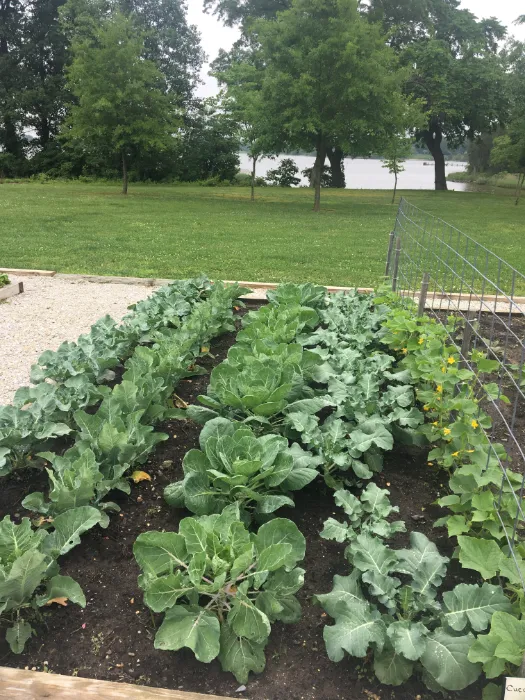The Best Vegetable Garden Layouts for Beginners

Disclosure: Some of the links in this article may be affiliate links, which can provide compensation to me at no cost to you if you decide to purchase. As a Amazon Associate, I earn on qualifying purchases
When planning a garden, it is important to consider the layout. A well-designed garden layout can make the difference between a successful garden and one that struggles.
Here are a few basics to keep in mind when planning the layout for your garden:
Sunlight:
One of the most important factors in a successful garden is sunlight. Make sure to take into account the amount of sunlight your garden will receive throughout the day. A vegetable garden needs more than 6 hours of full sun a day. Some vegetables, like tomatoes and peppers, like more upwards of 8 hours of sun to thrive.
Water:
Another important factor to consider is water. Make sure you have a plan for irrigation and know how much water your plants will need. Having the water source close by is key to maintaining an easy garden.
Soil:
The type of soil in your garden will also affect its success. Make sure to choose a soil that is well-drained and amended with organic matter.
Get a soil test done once a year to see what amendments it may need to optimize nutrient uptake. Your county cooperative extension agency has soil tests for free or at a low cost. Here is a list of the cooperative extension services by state.
Plants:
When selecting plants for your garden, it is important to choose varieties that are well-suited for your plant hardiness zone.
Are you thinking about starting a vegetable garden but not sure where to start?
Don't worry,
We've got you covered with four popular vegetable garden layout ideas to get you started.
Traditional row garden
This is a good option if you have a large space to work with. Simply create rows in the soil and plant your vegetables in them.
You can make your rows as wide or as narrow as you like, but we recommend making 2-3 feet between each row so you can easily walk between the rows.
You can till the soil with a tiller (Amazon) (this is the one i use), do it by hand or use a no till/low till method to get the garden ready for planting.
Raised bed garden
You can use the row method or square foot layout in this bedding system.
The square foot gardening layout, which is a popular choice when space is limited. The square foot method uses a grid system to plant vegetables in small square areas. This option is easy to care for and perfect for in the ground gardens or raised beds.
Raised beds are a good option if you have limited space or if you want to avoid bending over to tend to your plants. To create a raised bed, simply build a frame out of untreated wood or other materials and fill it with soil.
You can buy many different kinds of raised beds of varying heights and widths to fit in your unique space.
Here are some options:
48x24x30 inch raised garden bed:Amazon https://amzn.to/3ZzaaKD
17inches x 8ft x 2ft raised garden bed: Amazon https://amzn.to/3mDzwsi
17 inch beds(makes 2 beds):Amazon https://amzn.to/3FcxLJ3
6 x 3 x 2 foot raised garden bed: Amazon https://amzn.to/3l1IJtT
Container gardening
There are so many options when it comes to containers. Containers can be pots, fabric grow bags from Amazon window box containers, planters with trellises from Amazon, vertical gardens, etc.
You can even grow in buckets, just make sure whatever you grow in has sufficient drainage. It’s quite easy to drill a hole in the bottom or even the lower sides of of the bucket..
Make sure that you have sufficient depth for the vegetable’s root system in your container.
Some vegetables only need 12 inches of depth. These include herbs, corn, kale, spinach, lettuce, onions, strawberries and radishes, to name a few.
Peppers, carrots, beans, and squash need 18 inches of root depth.
Some plants, like tomatoes, watermelon, winter squash and sweet potatoes need 24 inches of depth.
So pick your containers carefully for successful plant growth.
Hydroponic system
These are meant to thrive indoors and can come in small systems for beginner gardeners.
For the beginner gardener, we recommend trying a table top version from Amazon. Hydroponics is a technique of growing plants using a water based nutrient solution rather than soil.
These table top versions come with everything you need to plant, germinate and grow the herbs or vegetables.
Choose any one of these easy methods to start the best garden layout for your yard or patio. Just start and don’t think about it too much. Gardening is a beautiful experiment, even for the advanced gardener.
Related Articles:
How to Choose the Best Cooling Sun Hat for Gardening
Pain Free Gardening: The Best Seats, Stools and Garden Carts
The Best Hand Pruners for Arthritic Hands: A Review
Disclosure: Some of the links in this article may be affiliate links, which can provide compensation to me at no cost to you if you decide to purchase. As a Amazon Associate, I earn on qualifying purchases


